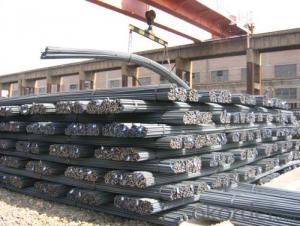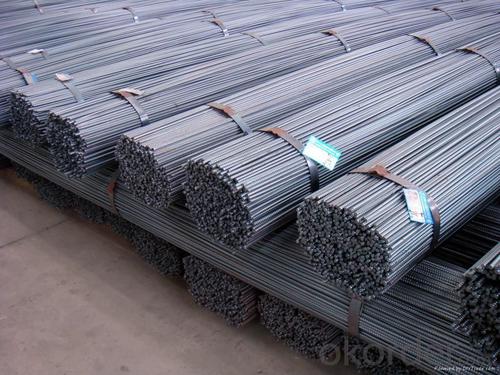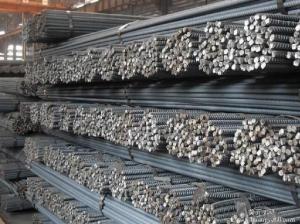Deformed bars in Grade HRB400 with High Quality
- Loading Port:
- Tianjin
- Payment Terms:
- TT OR LC
- Min Order Qty:
- 25 m.t.
- Supply Capability:
- 100000 m.t./month
OKorder Service Pledge
OKorder Financial Service
You Might Also Like
Product Description:
Specifications of HRB400 Deformed Steel Bar:
Standard | GB | HRB400 | |
Diameter | 6mm,8mm,10mm,12mm,14mm,16mm,18mm,20mm, 22mm,25mm,28mm,32mm,36mm,40mm,50mm | ||
Length | 6M, 9M,12M or as required | ||
Place of origin | Hebei, China mainland | ||
Advantages | exact size, regular package, chemical and mechanical properties are stable. | ||
Type | Hot rolled deformed steel bar | ||
Brand name | DRAGON | ||
Chemical Composition: (Please kindly find our chemistry of our material based on HRB500 as below for your information)
Grade | Technical data of the original chemical composition (%) | ||||||
C | Mn | Si | S | P | V | ||
HRB400 | ≤0.25 | ≤1.60 | ≤0.80 | ≤0.045 | ≤0.045 | 0.04-0.12 | |
Physical capability | |||||||
Yield Strength (N/cm²) | Tensile Strength (N/cm²) | Elongation (%) | |||||
≥400 | ≥570 | ≥14 | |||||
Theoretical weight and section area of each diameter as below for your information:
Diameter(mm) | Section area (mm²) | Mass(kg/m) | Weight of 12m bar(kg) |
6 | 28.27 | 0.222 | 2.664 |
8 | 50.27 | 0.395 | 4.74 |
10 | 78.54 | 0.617 | 7.404 |
12 | 113.1 | 0.888 | 10.656 |
14 | 153.9 | 1.21 | 14.52 |
16 | 201.1 | 1.58 | 18.96 |
18 | 254.5 | 2.00 | 24 |
20 | 314.2 | 2.47 | 29.64 |
22 | 380.1 | 2.98 | 35.76 |
25 | 490.9 | 3.85 | 46.2 |
28 | 615.8 | 4.83 | 57.96 |
32 | 804.2 | 6.31 | 75.72 |
36 | 1018 | 7.99 | 98.88 |
40 | 1257 | 9.87 | 118.44 |
50 | 1964 | 15.42 | 185.04 |
Usage and Applications of HRB400 Deformed Steel Bar:
Deformed bar is widely used in buildings, bridges, roads and other engineering construction. Big to highways, railways, bridges, culverts, tunnels, public facilities such as flood control, dam, small to housing construction, beam, column, wall and the foundation of the plate, deformed bar is an integral structure material. With the development of world economy and the vigorous development of infrastructure construction, real estate, the demand for deformed bar will be larger and larger..
Packaging & Delivery of HRB400 Deformed Steel Bar:
Packaging Detail: products are packed in bundle and then shipped by container or bulk vessel, deformed bar is usually naked strapping delivery, when storing, please pay attention to moisture proof. The performance of rust will produce adverse effect.
Each bundle weight: 2-3MT, or as required
Payment term: TT or L/C
Delivery Detail: within 45 days after received advanced payment or LC.
Label: to be specified by customer, generally, each bundle has 1-2 labels
Trade terms: FOB, CFR, CIF
- Q: Can steel rebars be used in the construction of government buildings?
- Yes, steel rebars can be used in the construction of government buildings. Steel rebars are commonly used in construction due to their high strength and durability, making them suitable for various building types, including government buildings. They provide reinforcement to concrete structures, increasing their load-bearing capacity and structural integrity, which is essential for the safety and longevity of government buildings. Additionally, steel rebars comply with industry standards and building codes, ensuring that the construction meets the necessary regulations and requirements.
- Q: Are steel rebars suitable for use in sports stadium construction?
- Yes, steel rebars are suitable for use in sports stadium construction. Steel rebars provide excellent strength and durability, making them ideal for reinforcing concrete structures, such as stadiums, that need to withstand heavy loads and impacts. They enhance the structural integrity of the stadium, ensuring its safety and long-term stability. Additionally, steel rebars offer flexibility in design and can be customized to meet specific construction requirements, making them a preferred choice in sports stadium construction.
- Q: What are the benefits of using stainless steel rebars?
- Using stainless steel rebars in construction projects offers several advantages. Firstly, they provide excellent resistance to corrosion, which is particularly crucial in environments with high humidity, coastal areas, or projects where the concrete will be exposed to water or chemicals. Unlike traditional carbon steel rebars, stainless steel rebars do not easily rust or corrode, ensuring the structure's long-term integrity and durability. Secondly, stainless steel rebars possess a higher tensile strength compared to carbon steel rebars. This means they can withstand greater forces and stresses without deforming or breaking. This makes them ideal for structures requiring a high load-bearing capacity, such as bridges, parking garages, and high-rise buildings. Moreover, stainless steel rebars have a low thermal expansion coefficient, meaning they do not significantly expand or contract with temperature changes. This property helps minimize cracking and structural damage caused by thermal stresses, ensuring the longevity and stability of the concrete structure. In addition to their mechanical properties, stainless steel rebars also offer aesthetic benefits. With their sleek and shiny appearance, they can enhance the visual appeal of architectural elements like exposed concrete walls or features in bridges and buildings. Lastly, stainless steel rebars are environmentally friendly as they are 100% recyclable, making them a sustainable choice for construction projects. By utilizing stainless steel rebars, builders and engineers can contribute to reducing the carbon footprint and promoting a greener construction industry. Overall, the advantages of using stainless steel rebars include superior corrosion resistance, high tensile strength, low thermal expansion, aesthetic appeal, and environmental sustainability. These benefits make stainless steel rebars the preferred choice for various construction applications, providing long-lasting and reliable reinforcement for concrete structures.
- Q: Are steel rebars resistant to chemicals?
- Yes, steel rebars are generally resistant to chemicals. Steel is known for its high strength and durability, and it can withstand exposure to various chemicals without significant deterioration. However, the level of resistance may vary depending on the specific chemical and the concentration or duration of exposure. In general, steel rebars are highly resistant to common chemicals found in construction materials and environments, such as water, concrete additives, and standard cleaning agents. They are also resistant to many acids, alkalis, and organic solvents. However, some aggressive chemicals like strong acids or oxidizing agents may cause corrosion or damage to steel rebars over time. Therefore, it is important to consider the specific chemical environment when selecting and using steel rebars, and take appropriate measures to protect them if necessary, such as using protective coatings or corrosion inhibitors.
- Q: How do steel rebars affect the overall crack width of concrete structures?
- Steel rebars can significantly reduce the overall crack width of concrete structures. By reinforcing the concrete, rebars help distribute and resist tensile forces, preventing cracks from widening or forming in the first place. This reinforcement enhances the structural integrity and durability of the concrete, ensuring it can withstand external loads and environmental factors.
- Q: Can steel rebars be painted or coated?
- Steel rebars can indeed be painted or coated, a common practice in construction and engineering for protecting against corrosion and enhancing their appearance. The procedure involves applying a layer of paint or coating substance onto the rebars' surface. This protective layer acts as a barrier, preventing moisture and other corrosive elements from reaching the steel, thereby extending the rebars' lifespan. Furthermore, painting or coating the rebars aids in distinguishing them from other construction materials or facilitating color-coded identification. It is crucial to utilize top-notch paint or coating materials specifically formulated for steel applications to ensure adequate adhesion and durability.
- Q: Thread steel generally used for more?
- Mainly used for reinforcement of reinforced concrete and prestressed concrete structures. It is one of the most widely used kinds of steel in civil engineering.
- Q: What is the length and size of thread steel?
- Domestic sales of domestic thread steel, if the contract does not specify requirements, usually fixed length of 9m, 12m two length.
- Q: What are the guidelines for proper storage and transportation of steel rebars?
- The guidelines for proper storage and transportation of steel rebars include keeping them off the ground to avoid moisture and corrosion, storing them in a well-ventilated area, organizing them in a neat and stable manner to prevent falling or shifting, protecting them from direct exposure to weather conditions, and securing them properly during transportation to avoid damage or accidents.
- Q: How do steel rebars affect the overall safety of construction projects?
- Steel rebars play a crucial role in enhancing the overall safety of construction projects. By reinforcing concrete structures, rebars significantly increase their strength, durability, and resistance to various forces such as tension, compression, and shear. This reinforcement helps prevent structural failure, collapse, and damage caused by external factors like earthquakes, heavy loads, or extreme weather conditions. Ultimately, the use of steel rebars ensures the stability and integrity of construction projects, ensuring the safety of occupants and the longevity of the structures.
Send your message to us
Deformed bars in Grade HRB400 with High Quality
- Loading Port:
- Tianjin
- Payment Terms:
- TT OR LC
- Min Order Qty:
- 25 m.t.
- Supply Capability:
- 100000 m.t./month
OKorder Service Pledge
OKorder Financial Service
Similar products
Hot products
Hot Searches
Related keywords


























